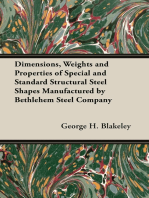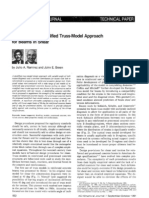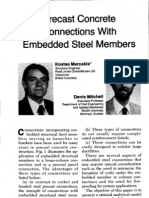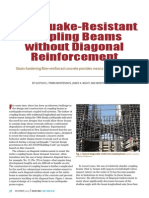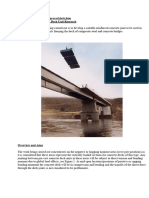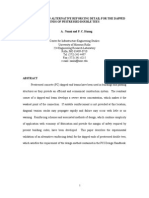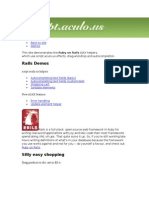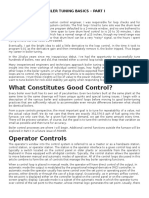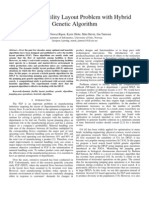87 s10
87 s10
Uploaded by
carlosestayCopyright:
Available Formats
87 s10
87 s10
Uploaded by
carlosestayOriginal Title
Copyright
Available Formats
Share this document
Did you find this document useful?
Is this content inappropriate?
Copyright:
Available Formats
87 s10
87 s10
Uploaded by
carlosestayCopyright:
Available Formats
ACI STRUCTURAL JOURNAL
TECHNICAL PAPER
Title no. 87-510
Strut-and-Tie Models for the Design of Pile Caps:
An Experimental Study
by Perry Adebar, Daniel Kuchma, and Michael P. Collins
Describes the test results from six large pile caps that failed in twoway shear. A CI Building Code procedures for the shear design of pile
caps are unable to predict the experimental results because the procedures neglect certain important parameters, such as the amount of
longitudinal reinforcement, and overemphasize other parameters,
such as the effective depth. Strut-and-tie models were found to describe more accurately the behavior of deep pile caps.
Keywords: building codes; caps (supports); deep beams; footings; piles; reinforced concrete; shear strength; structural design; tests.
A pile cap is a structural member whose function is
to transfer load from a column to a group of piles [see
Fig. 1(a)]. Current design procedures for pile caps do
not provide engineers with a clear understanding of the
physical behavior of these elements. Strut-and-tie
models, on the other hand, can provide this understanding and hence offer the possiblity of improving
current design practice.
The design procedure for pile caps given in the ACI
Building Code (ACI 318-83) is a "sectional force" approach similar to that used for two-way slabs. The procedure is divided into two separate steps: (1) shear design, which involves calculating the minimum pile-cap
depth so that the concrete contribution to shear resistance is greater than the shear applied on the defined
pseudocritical section; and (2) flexural design, in which
the usual assumptions for reinforced concrete beams
are used to determine the required amount of longitudinal reinforcement.
Strut-and-tie models consider the complete flow of
forces within the structure rather than just the forces at
one particular section. The internal load path in
cracked reinforced concrete is approximated by an
idealized truss [see Fig. 1(b)]. Zones of concrete with
primarily unidirectional compressive stresses are modeled by compression struts, while tension ties are used
to model the principal reinforcement. The areas of
concrete where struts and ties meet, referred to as nodal
zones, are analogous to the joints of a truss (see Fig. 2).
While truss models have been used in reinforced conACI Structural Journal I January-February 1990
crete design since the turn of the century, recent work
has refined and improved these models.'""
A simple design procedure that uses strut-and-tie
models forms part of the new shear design provisions
of CAN3 A23.3-M84, the Canadian concrete code. 56
The procedure is used for regions near statical or geometrical discontinuities where it is inappropriate to assume that shear stresses are uniformly distributed over
the depth of the member. In addition to the usual equilibrium conditions of strut-and-tie models, the Canadian code requires some consideration of compatibility
conditions.
Many experimental studies have confirmed the suitability of strut-and-tie models for deep beams, e.g.,
References 7 and 8. Unlike deep beams, pile caps are
large blocks of concrete containing little reinforcement.
They usually contain no transverse shear reinforcement
and only small percentages of longitudinal reinforcement. This paper reports the results of six large pile-cap
tests designed to examine the suitability of three-dimensional strut-and-tie models for pile-cap design.
PREVIOUS TESTS ON PILE CAPS
Blevot and Fremy9 conducted a comprehensive series
of tests on about 100 pile caps, most of which were
half-scale, to investigate the influence of different reinforcement arrangements. In the case of four-pile caps
(i.e., pile caps supported on four piles), they found that
spreading out the reinforcement uniformly (as suggested by the ACI Building Code) reduced the failure
load by 20 percent compared to a pile cap with the
same quantity of reinforcement but with all the reinforcement concentrated over the piles (as suggested by
ACI Structural Journal, V. 87, No. I, January-February 1990.
Rec~ived Jan. 5, 1989, and reviewed under Institute publication policies.
Copyng~t 1990, American Concrete Institute. All rights reserved, including
the makmg of copies unless permission is obtained from the copyright proprietor. Pertinent discussion will be published in the November-December 1990
ACI Structural Journal if received by July I, 1990.
81
ACI member Pe"y A debar is a doctoral candidate in the Department of Civil
Engineering at the University of Toronto. He holds engineering degrees from
Lakehead University and the University of Toronto.
Daniel Kuchma is a doctoral candidate in the Department of Civil Engineering
at the University of Toronto.
Michael P. CoUins, FACI, is a professor in the Department of Civil Engineering at the University of Toronto. He is a member of Joint ACI-ASCE Committee 445, Shear and Torsion; and of ACI Committees 358, Concrete Guideways, and E901, Scholarships; and of Subcommittee 3/BE, Shear and Torsion.
He has acted as a consultant on the shear design of Condeep concrete offshore
platforms.
strut-and-tie models). For three-pile caps, spreading the
reinforcement uniformly across the width caused a 50percent reduction in strength.
Clarke 10 tested 15 four-pile caps at one-half scale to
study the influence of reinforcing-steel layout and reinforcing-bar anchorage. He found that spreading the reinforcement out uniformly reduced the failure load by
14 percent. For pile caps with reinforcement concentrated over the piles, Clarke observed that the anchorage of reinforcing bars was enhanced by the confining
action of the compression struts.
Sabnis and Gogate 11 recently tested nine four-pile cap
models at one-fifth scale with varying amounts of uniformly placed reinforcement. They concluded that the
ACI Building Code requires "major revisions to properly reflect the behavior of thick pile caps."
PRESENT EXPERIMENTAL STUDY
Fig. l(a)-Pile cap supported on four piles
Details of the six test specimens are given in Fig. 3
and Table 1. Pile Caps A, B, D, and E were all fourpile caps with identical external dimensions. Pile Cap A
was designed in accordance with the ACI Building
Code (ACI 318-83) for an ultimate column load of
about 2000 kN (450 kips). The calculated reinforcement was not increased to satisfy minimum temperature and shrinkage reinforcement requirements. Pile
Cap B was designed using a strut-and-tie model for a
column load of 2000 kN (450 kips). Pile Cap D was
constructed with twice as much reinforcement as Pile
Cap B to investigate failure prior to yielding of the reinforcement. Pile CapE was similar to Pile Cap D, except it contained distributed reinforcement.
Pile Cap C was supported on six piles and was designed using a strut-and-tie model for a 3000-kN (675kip) load.
Pile Cap F was constructed to test a hypothesis of the
ACI Building Code. It was made identical to Pile Cap
II
v
Fig. J(b)-Simple three-dimensional truss model for a
jour-pile cap
82
T
D
VI tanO
VI sinO
Fig. 2-Components of the idealized load-resisting
truss
ACI Structural Journal I January-February 1990
D except that four "corner" pieces of plain concrete
were omitted (see Fig. 3). Because of these missing
pieces of concrete, the ACI Building Code predicts that
Pile Cap F will have a much lower strength than Pile
Cap D. The strut-and-tie model suggests that Pile Caps
D and F will have essentially the same strength.
In designing the pile caps, it was assumed that the
column load would be equally shared among all the
piles, as is the usual assumption in pile-cap design.
However, it is important to recognize that the loads in
the piles are, in fact, statically indeterminate and are
influenced by the relative stiffnesses of the individual
piles. In this study, the stiffnesses of the pseudo-piles
were not uniform.
The pile caps all had an overall depth of 600 mm (24
in.) and were loaded through 300 mm (12 in.) square
cast-in-place reinforced concrete columns. They were
supported by 200 mm (8 in.) diameter precast reinforced concrete piles embedded 100 mm (4 in.) into the
underside of the pile caps [Fig. 3(b)].
The concrete used to construct the pile caps was obtained from a ready-mix supplier. A compressive
strength of 20 MPa (2900 psi) was specified. Results
from tests on standard cylinders of the concrete are
given in Table 2. Properties of the reinforcing bars are
given in Table 3.
Table 1 Tension
tie mark
(see Fig. 3)
(a) Plan Views
E
E
PILE CAP A
TA1
PILE CAP 8
PILE CAP C
Summary of reinforcement
Reinforcing steel
9-No. 10* at 260 mm
Area of
steel,
mm'
Depth to
centroid,
mm
900
440
TA2
15-No. 10 at 100 mm
1500
450
TBI
4-No. 10 at 70mm
4-No. 10 at 70mm
4-No. 10 at 70mm
400
400
400
1200
340
390
440
TB2
6-No. 10 at 45 mm
8-No. 10 at 45mm
8-No. 10 at 45 mm
800
800
600
2200
350
400
450
TC2
3-No. 10 at 45mm
5-No. 10 at 45 mm
3-No. 10 at 45mm
300
500
300
1100
340
390
440
TC3
7-No. 10 at 45 mm
7-No. 10 at 45mm
7-No. 10 at 45 mm
700
700
700
2100
350
400
450
TDl
4-No. 151 at 70 mm
4-No. 15 at 70 mm
4-No. 15 at 70 mm
800
800
800
2400
330
380
430
TD2
8-No. 15 at 45mm
8-No. 15 at 45 mm
8-No. 15 at 45 mm
1600
1600
1600
4800
350
400
450
TE3
9-No. 10 at 210 mm
900
495
TE4
5-No. 10 at 240 mm
500
485
TE5
1-No.
1-No.
1-No.
1-No.
100
100
200
200
250
325
400
470
TAl
The total load applied to the pile cap and the load
carried by each pile were measured using load cells.
Vertical and horizontal deflections of the pile caps were
measured with displacement transducers and mechanical dial gages. Electrical-resistance strain gages were in-
10
10
15
15
*No. 10 is a 11.3 mm diameter bar with a cross-sectional area of 100 mm'.
'No. 15 is a 16.0 mm diameter bar with a cross-sectional area of 200 mm'.
I mm' = 0.015 in.'; I mm = 0.0394 in.
ACI Structural Journal I January-February 1990
PILE CAP D
PILE CAPE
PILE CAP F
(b) Cross Section
of Pile Caps 8, D,
and F.
200 mm dia. pile
Fig. 3-Test specimens
83
stalled at numerous locations along selected reinforcing
bars, and demountable strain gages were used to measure average strains on some surfaces. To determine
strains within the large volume of plain concrete, as
many as 20 embedment strain gages, with 75 mm (3 in.)
gage lengths, were cast into each specimen.
A universal testing frame was used to apply concentric compressive load onto the columns. Short reinforced concrete piles were supported on steel pedestals,
which in turn were supported on rubber pads and nonstick synthetic-resin-coated sliding bearings (see Fig. 4).
The load on the specimens was increased monotonically to failure, stopping at approximately 10 deformation stages to take manual displacement readings and to
photograph crack development. All electronic measurements were automatically recorded during the test
by a computerized data acquistion system.
Fig. 4-Pi/e CapE being tested
EXPERIMENTAL OBSERVATIONS
The observed load-deflection relationships for the six
specimens are shown in Fig. 5. The pile cap center deflection, load distribution among the piles, and reinforcing-bar strains, at both cracking load and ultimate
load, are shown in Table 4. In Pile Caps A and B,
which were lightly reinforced, the reinforcing strains
increased very suddenly when the first crack formed.
Both the strains immediately before and immediately
after cracking are shown in the table.
The pile caps typically had very few cracks prior to
failure. One flexural crack usually occurred in each
span between the piles. In the diamond-shaped specimens (Pile Caps A, B, D, and E), the flexural cracks
extended diagonally between the piles (see Fig. 6). Failure in all pile caps was characterized by the rapid development of many new cracks.
Pile Cap A was predicted to fail at a total load of
2138 kN (481 kips) by the design equations of the ACI
Building Code, with flexure being critical. However,
the specimen failed at only 83 percent of this predicted
load, namely 1781 kN (401 kips). Fig. 6 shows the deformation pattern at failure. The zones that are shaded
in the figure moved down relative to the unshaded
zones to produce a typical two-way shear failure cone.
The flexural reinforcement yielded prior to failure.
Pile Cap B was similar to Pile Cap A except for the
reinforcement, which was designed according to a strutand-tie model for equal pile loads of 500 kN (112.5
kips), e.g., a 2000 kN (450 kip) total load. The majority of the load was initially carried to the two piles
closest to the column. After the tension tie in the short
direction yielded, the load distribution among the piles
began to change. The specimen failed before significant redistribution occurred. The pile cap resisted a
maximum load of 2189 kN (492.5 kips). The tension tie
in the long direction did not yield. For the physical appearance of Pile Cap B after testing, see Fig. 7.
Table 2 -
Pile
Cap
Results of concrete cylinder tests
Tensile strength
from indirect
tension tests, MPa
Cylinder compressive test
Strain
Secant
Peak
at
modulus,*
stress,
peak
MPa
MPa
stress
D
E
F
19,400
19,400
26,000
28,600
31,600
28,600
24.8
24.8
27.1
30.3
4l.l
30.3
0.0024
0.0024
0.0020
0.0020
0.0022
0.0020
Split
cylinder
Double
punch"
2.9
2.9
3.7
2.2
2.7
2.2
2.0
2.5
2.0
*Secant modulus measured to a stress of 0.4 J:.
I MPa = 145 psi.
Table 3 -
PILE CAP DEFLECTION
Fig. 5-Load-def/ection relationships for the six test
specimens (1 kN
84
0.225 kips; 1 mm
0.0394 in.)
Properties of reinforcing steel
Bar
designation
Nominal
area,
mm'
Yield
load,
kN
Yield
stress
}"y,MPa
hfE,
No. 10M
No. 15M
100
200
47.9
97.2
479
486
0.0024
0.0024
E, (Young's modulus of steel) = 200,000 MPa.
I mm' = 0.0015 in.'; I kN = 0.225 kip; I MPa
Ultimate
stress,
MPa
610
646
145 psi.
ACI Structural Journal I January-February 1990
Pile Cap C was designed for six equal pile loads of
500 kN (112.5 kips), i.e., a column load of 3000 kN
(675 kips). As in Pile Cap B, the vast majority of the
load was resisted by the two piles closest to the column, while the four outer piles resisted very little load.
Even though the strain of the tension tie between the
center two piles reached the yield strain, very little de-
formation occurred because of the restraint provided by
the adjoining portions of the pile cap (see Fig. 3). When
the total column load reached 2892 kN (651 kips), a
shear failure occurred. A punching cone extended from
the column's outside faces to the piles' inside edges
(Fig. 8). The two piles closest to the column had maximum individual loads of 1150 kN (259 kips) each.
Table 4 - Summary of experimental
observations
Reinforcing
Pile load
distribution
bar strain
Load on Load on
closest
other
Between !Between
other
Center two piles, piles,
closest
two
piles, piles,
deflection,
kN
kN
fLOad,
(percent) (percent mm/m mm/m
Pile Cap kN
mm
A
1186
0.10
676
(57)
510
(43)
0.11
1.34*
0.20
1.10*
1679
0.04
1461
(88)
218
(12)
0.38
1.43*
0.05
0.67*
1780
0.15
1615
(91)
165
(9)
0.11
0.05
"'c0
1122
0.16
823
(73)
299
(27)
0.06
0.05
1:.,
1228
0.11
910
(74)
318
(26)
0.01
0.01
650
0.18
474
(73)
176
(27)
0.09
0.20
1781
1.59
1247
(70)
534
(30)
13.0
2.6
2189
1.07
1575
(72)
614
(28)
9.2
1.3
2892
2.06
2303
(80)
589
(20)
2.4
1.0
3222
3.37
2205
(68)
1017
(32)
1.9
1.3
4709
2.50
3243
(69)
1466
(31)
0.8
0.4
3026
3.21
2059
(68)
965
(32)
2.2
1.1
01)
:;2
...u
OS
"'
.I:>
.,...
::I
~
~
a
0
-~
1:.,
"'
.I:>
*Strain immediately after cracking.
I kN = 0.225 kip; I mm = 0.0394 in.
(a)
Reflected View of Bottom and Sides
(b) Top Surface and Sides
Fig. 6-Fina/ deformation pattern of Pile Cap A
Fig. 7-Appearance of Pile Cap B after testing
ACI Structural Journal I January-February 1990
85
------
Fig. 8-A view of the punching cone in Pile Cap C after part of the specimen was
removed
Fig. 9(a)-Sequence of relevant crack formations in
Pile CapF
Fig. 9(b)-Appearance of failure zone in Pile Cap F
after testing
86
Pile Caps D and E, which were similar to Pile Cap B
except that they had twice as much reinforcement, both
failed prior to yielding of either tension tie. Once again
the failure surfaces resembled typical punching shear
cones. Pile Cap D failed at a column load of 3222 !:N
(735 kips) with a maximum individual pile load of 1119 kN (252 kips). Pile CapE failed when the column load
was 2709 kN (1060 kips) and the maximum individual
pile load was 1655 kN (372 kips). Pile Cap E was
stronger than Pile Cap D because of the distributed reinforcement in that specimen and also the higher concrete strength.
Pile Cap F was similar to Pile Cap D except for the
four "missing corners" of plain concrete. The specimen resembled two orthogonal deep beams intersecting
at midspan. Failure occurred when the short beam
failed in shear. The sequence of relevant crack formations in the shorter span beam is illustrated in Fig. 9(a).
The first cracks to form were flexural cracks at midspan, which propagated up the interface of the two
beams labeled 1 in Fig. 9(a). A vertical crack, labeled
2, then appeared directly above the pile. At a pile load
of 949 kN (214 kips}, a new diagonal crack suddenly
appeared (Crack 4). Analogous to a web-shear crack,
this diagonal crack formed independently of any previously existing cracks. With a small increase in load, the
diagonal crack widened considerably. The specimen
failed when the shear in the short beam, i.e., the shortdirection pile load, was 1077 kN (242 kips) and the total column load was 3026 kN (681 kips). None of the
longitudinal reinforcement yielded. The appearance of
the failure zone can be seen in Fig. 9(b).
More detailed experimental observations are reported in References 12 and 13.
The ACI Building Code suggests that the usual procedures for flexural design be applied in designing the
longitudinal reinforcement in a pile cap. Fundamental
to these "beam" procedures is the assumption that
plane sections remain plane. To investigate the validity
ACI Structural Journal I January-February 1990
0.003.-----------,
Yield
strain--
0.1
0.2
0.002
r-
0.001
r-
2891
~:;;;.r.:::;:L~
.~
!>,..~/""'
~Oj
.
.
/
""'
__!~~1!,!!8::_:72:._:k:::N~-..:_-_:-====-::!L..J
Bottom
of
pile
cap
0.1
,0
,.,."'
0L
0.3
STAAl N ( x 10'3 )
Top
of
pile
cap
(a) Short Direction of Pile Cap C
0.003.------------------,
Yield
strainBottom
of
pile
~------~~----~--~~--~---7---cap
STRAIN
( x 10'3 )
Yield
strain
Fig. 10-Measured vertical strain profiles in long direction of Pile Cap A at various column loads (1 kN =
0.225 kips)
of this assumption, the variation of horizontal strain
over the depth of the pile caps was measured directly
beneath the column. Both embedment strain gages in
concrete and strain gages on reinforcing bars were used.
The ACI Building Code states that a nonlinear distribution of strain need not be considered if the overall
depth-to-clear span ratio is less than 0.8 for simply
supported members. Fig. 10 shows the measured strain
profiles in the long direction of Pile Cap A at various
load stages. The overall depth-to-clear span ratio for
this case is about 0.4. However, it can be seen that the
strain distributions are highly nonlinear both prior to
cracking at a load of 1186 kN (267 kips) and after
cracking.
In a member that resists shear by true "beam action," the tension force in the longitudinal reinforcement changes along the beam to balance the applied
bending moment, while the flexural lever arm remains
relatively constant. 14 Alternatively, if the tension force
remains constant, the flexural lever arm changes and
the member acts as a tied arch with the shear being resisted by inclined compression, i.e., "strut action." Fig.
11 shows typical examples of longitudinal reinforcing
strain variations measured in the pile caps. While the
sectional bending moment varies linearly from maximum at midspan to zero at the piles, the tensile force
in the reinforcement varies much less. The measured
tension in the reinforcement had its highest value at
midspan, but the reinforcement over the piles still carried up to 75 percent of this maximum tension. It is
perhaps the main advantage of strut-and-tie models
ACI Structural Journal I January-February 1990
(b)
Long Dlraction of Pile Cap D
Fig. 11-Typical examples of longitudinal reinforcing
strain variations measured at various column loads (1
kN = 0.225 kips)
that they clearly indicate to the designer the need to anchor the longitudinal reinforcement so that it can develop this high tension force at the piles.
Another important assumption in the ACI Building
Code "beam method" of pile-cap design is that the full
width of the pile cap uniformly resists the applied
bending moment. To investigate this assumption, longitudinal strains on the top surfaces of the pile caps
were measured across the widths of the pile caps. The
observed strain profiles for Pile Cap A at a column
load of 1706 kN (384 kips) are shown in Fig. 12. Even
though the flexural reinforcement was yielding and the
pile cap was very close to failure, the compressive
strains on the top surface remained relatively low. Also,
the surface strains were far from uniform, indicating
that the bending moment was resisted mainly by the
central portion of the pile cap, as suggested by the
strut-and-tie model.
To gather more information on the zones of concrete
that resist the load, an array of embedment strain gages
was installed in Pile Cap A and Pile Cap B [see Fig.
13(a)]. Note that the embedment gages measured the
87
-3
-2
-1
compressive strains in the struts joining the column to
the two more distant piles, but the majority of the load
was traveling to the closer piles. The measured strains
were used to draw the strain contours shown in Fig.
13(b) and 13(c). It is interesting to note that in both pile
caps the compressive strains reached their highest value
at the location where the strut-and-tie model suggests
the center of the compression strut is located.
+1
X 10"3
-3
-2
-1
+1
10"3
Fig. 12-Longitudinal strains on top surface of Pile
Cap A at approximate failure, i.e., column load of
1706 kN (384 kips)
G)~
@)
--8-11-....
G).J (\)
(a) Location of Embedment Strain Gauges
-----Embedment
~'L
100 mm
(b) Compressive Strain Contours in Pile Cap A at Failure
Numbers shown are microstrain, ie. x 1o6
---------------
------------100-----....
--
CD-.
--<D
100 mm
(c) Compressive Strain Contours in Pile Cap B at Failure
Numbers shown are microstrain, le. x 10-6
Fig. 13-Contours of compressive strain in zones of
concrete that resist load
88
COMPARISON OF OBSERVED STRENGTHS
WITH ACI BUILDING CODE PREDICTIONS
The requirements for the design of footings, including those supported on piles, are given in Chapter 15,
Footings, of ACI 318-83. The procedure is divided into
two separate parts, design for moment and design for
shear.
The ACI Building Code specifies the location of the
critical section for moment in footings. The quantity of
longitudinal reinforcement required at this section is
determined by the usual procedures for reinforced concrete members outlined in Chapter 10, Flexure and Axial Loads. The designer is told to distribute the required longitudinal reinforcement uniformly across the
footing (except that the short-direction reinforcement
of rectangular footings must be somewhat more concentrated near the center of the pile cap).
The shear strength of footings is required to be in
accordance with Section 11.11, Special Provisions for
Slabs and Footings. The shear strength of slabs and
footings is said to be governed by the more severe of
two conditions: beam action, where the footing is considered to be acting as a wide beam; and two-way action, where failure occurs by punching along a truncated cone. In the first case the critical section is a plane
located d from the face of the column, whereas in the
second case the critical surface is at d/2 from the perimeter of the column. In calculating the shear in a
footing, any pile located inside the critical section is
considered to produce no shear according to Paragraph
15.5.3.
The procedures of the ACI Building Code were used
to predict the failure loads of the test specimens (see
Table 5). Pile Cap A was predicted to fail in flexure,
while all other specimens were predicted to fail in shear.
All specimens, including Pile Cap A, actually failed in
shear.
Pile Cap A, the specimen designed according to the
ACI Building Code, failed in two-way shear at 83 percent of the predicted load. The low strength of this
specimen was due to yielding of the longitudinal reinforcement in the short direction that triggered a punching shear failure.
The predicted two-way shear strength of Pile Cap A
is 2366 kN (528 kips), 29 percent greater than the predicted two-way shear strength of Pile Cap B. The difference is large because the predictions are very sensitive to the effective depth d. Pile Cap A had one layer
of longitudinal reinforcement, while Pile Cap B had
three layers, resulting in a smaller effective depth to the
centroid of the reinforcement. The experimental results
ACI Structural Journal I January-February 1990
Table 5 - Comparison of ACI predictions and
experimentally observed failure loads
Pile Cap
A
B
E
F
Concrete
strength
J:, MPa
24.8
24.8
27.1
30.3
41.1
30.3
ACI predicted
failure loads,
kN
Flexure Shear
2366
1833
1898
1966
2451
1204
2138
2778
4086
5645
7404
5187
Experimental
load,
kN
Exp.
Pred.
1781
2189
2892
3222
4709
3026
0.83
1.19
1.52
1.64
1.92
2.51
I
l
l
l
l
l
d/2 :---
'l
:-critical section
for twoway shear
, ____ J
Compression
Mean = 1.60
Coefficient of variation = 36.4117o
I MPa = 145 psi; I kN = 0.225 kip.
were actually opposite to those that had been predicted: Pile Cap B was in reality 23 percent stronger
than Pile Cap A.
The strong influence of amount of longitudinal reinforcement can be seen if Pile Cap B is compared with
Pile Cap D. The ACI Building Code predicts that Pile
Cap D should only be 7 percent stronger than Pile Cap
B because of its higher concrete strength. Pile Cap D,
which contained twice as much longitudinal reinforcement, was in fact 47 percent stronger than Pile Cap B.
The ACI Building Code expressions for two-way shear
strength are independent of the amount of longitudinal
reinforcement.
Pile Caps D and F were identical except that four
"corner" pieces of plain concrete were omitted in Pile
Cap F. Because of these missing pieces of concrete, the
ACI Building Code expressions predict that Pile Cap D
will be 63 percent stronger than Pile Cap F. This great
difference in predicted strength results from the fact
that Pile Cap D is predicted to fail in two-way shear,
while Pile Cap F is predicted to fail in one-way shear
(see Fig. 14). The strut-and-tie model suggests that
concentrated zones of concrete (compression struts)
transmit the load and that failure occurs when the stress
in a compression strut reaches some critical value. The
strut-and-tie model predicts little difference between the
strengths of Pile Caps D and F, which had identical
concrete strengths. The failure loads of the two specimens actually differed by less than 7 percent.
FAILURE OF COMPRESSION STRUTS
If a tension tie crosses a compression strut, the required tensile straining can reduce the capacity of the
concrete to resist compressive stress. 15 In pile caps, tension ties cross compression struts in the vicinity of the
nodal zones just above the piles. For four of the pile
caps tested, the average biaxial strains of these critical
regions were measured using two embedment strain
gages in the concrete and one strain gage on a reinforcing bar at each location. See Fig. 15. The measured
biaxial strains are presented in Table 6 in terms of
principal strains. For Pile Cap C, the strains are shown
at increasing load levels from before cracking up to
failure. Also, for the three other specimens, the strains
at failure are presented. In none of the pile caps did the
principal compressive strain reach very high values.
ACI Structural Journal I January-February 1990
PILE CAP D
PILE CAP F
Fig. 14-ACI Building Code critical sections for shear
capacity in Pile Cap D and Pile Cap F
Embedment
strain gauge - -~--
""'~I/
~~I
1
Strain
gauge
Fig. 15-Interna/ biaxial strain measurements
Further, the principal tensile strains remained relatively
small. These strain values indicate the compression
struts did not fail by crushing of the concrete.
The strut-and-tie model shown in Fig. 2 is a very
simple idealization of force flow. More refined strutand-tie models can be developed by considering the
flow of elastic stresses. 1 Since pile caps remain virtually
uncracked until failure, the linear elastic stress distributions are especially relevant. Fig. 16(a) shows the
biaxial stress trajectories determined from a linear elastic finite element study. Note that between the points of
load application, the compressive stresses spread out,
producing transverse tensile stresses. A refined truss
model, which includes a concrete tension tie to resist
the transverse tension, is shown in Fig. 16(b). It is believed that failure of this concrete tension tie was the
critical mechanism involved in the shear failures of the
pile caps tested.
89
Table 6 - Average biaxial strains at
intersections of compression struts and tension
ties
Pile
Cap
Load,
kN
1007
1513
2006
2312
2591
2607
2752
2891
D
3222
e,
JO-'
0.07
0.11
0.16
0.21
0.66
1.20
1.78
2.66
2.33
e,
w-'
-0.05
-0.08
-0.11
-0.14
-0.30
-0.40
-0.52
-0.69
-1.20
IJ,
deg*
57.5
58.0
58.8
59.8
60.9
62.9
63.8
64.6
57.3
1.50
-"
-"
::t:
1-
1.25
"a:z
w
1-
e
e
Cii
"'
U)
>
U)
a:
0..
:;;
0
(,)
4709
0.66
-0.28
64.7
3026
1.97
-0.89
57.6
::::;
>
(,)
0
0
a:
*82 is measured from horizontal.
I kN = 0.225 kip.
b = 152 mm
(6 in.)
0.75
li~~
152~8
(6 in.)
1-
U)
U)
a:
1-
U)
"za:
<(
Experimental:
u.
Cracking
OUitimate
i=
fc' = 30 MPa
w
m
0
0
<(
a:
RATIO OF SPECIMEN WIDTH TO LOADED WIDTH
Fig. 16(a)-Linear elastic stress trajectories showing
transverse tensioning due to spreading of compression
in Pile CapF
Fig. 16(b)-Refined truss model that includes a concrete tension tie to resist transverse tension
Rather than employing a refined strut-and-tie model,
the simple truss model combined with an appropriate
failure criterion for the compression strut can be used. 1
Fig. 17 summarizes a series of simple tests conducted by
the authors to demonstrate the influence of transverse
tension on the failure of compression struts. Seven
plain concrete specimens with constant height and
thickness but with varying widths were loaded in uniaxial compression, using the same size loading plate in
all cases. In all but the most narrow specimen, the
compression spread out, causing transverse tension,
which split the specimens. The measured cracking
loads, expressed in terms of the bearing stress, are
compared with an elastic finite element prediction. In
making this prediction, cracking was assumed to occur
90
8/b
Fig. 17-Simple tests to demonstrate the influence of
transverse tension
when the maximum tensile stress reached 3.3 MPa
(1579 psi).
For these plane-stress specimens, the minimum bearing stress at cracking was approximately 0.5f;, but in a
pile cap the compressive stresses spread in two directions, reducing the transverse tension in any one direction. Chen 16 conducted a series of tests on variously
sized concrete cylinders loaded in uniaxial compression
through small round loading disks (double-punch test).
In these tests the concrete cracked at a minimum bearing stress of 1.5f:.
In the author's plane stress tests, the concrete continued to carry load after cracking (see Fig. 17), while
in Chen's double-punch tests, failure was always coincident with cracking. In pile caps, the absence of reinforcement to control diagonal cracking allows the
cracks that occur due to splitting of the struts to propagate quickly through the specimen. Depending on the
geometry of the pile cap, the final kinematically feasible failure mechanism resembles either a one-way or
two-way shear failure.
It has been suggested 1 that if the maximum bearing
stress is less than some critical value, a splitting strut
failure will be prevented. Examining the maximum
bearing stress in those pile caps that had strut failures,
it appears a limit on the maximum bearing stress of
about 1.0f: is reasonably conservative for pile caps (see
Table 7). Note that if the pile cap capacities are predicted using the simple maximum bearing stress rule,
the coefficients of variation are 10.9 and 4.8 percent for
ACI Structural Journal I January-February 1990
the pile and column bearing stresses, respectively. For
the same pile caps, the ACI 318 predictions of shear
strength give a coefficient of variation of 23 percent.
COMPARISON WITH CANADIAN
CONCRETE CODE
The Canadian concrete code 5 shear-design rules,
which make use of strut-and-tie models, were intended
for plane structures such as corbels or deep beams;
however, they are general enough that they can be applied to pile caps. The Canadian code requires that the
concrete compressive stress in nodal zones of strut-andtie models does not exceed 0.85!: in nodal zones
bounded by compressive struts, 0. 75f: in nodal zones
anchoring only one tension tie, and 0.60f: in nodal
zones anchoring more than one tie. The Canadian code
also requires that the necessary tension-tie reinforcement be effectively anchored to transfer the required
tension to the nodal zones. Finally, the concrete compressive stress in struts must not exceed the crushing
strength of the cracked concrete determined by considering the strain conditions in the vicinity of the strut.
Further details can be found in Reference 6.
Table 8 compares the Canadian code's predicted
strengths of the test specimens with the experimentally
observed failure loads. For Pile Cap A, failure is predicted to occur when the longitudinal reinforcement
yields. For all other pile caps, the limitation that the
column bearing stress must not be greater than 0.85 J:
is critical.
The limitation on concrete compressive stress in the
struts was not critical for the pile caps tested. However, the strength of shallower pile caps with flatter
compression struts may be limited by the compression
in the struts, since the strength of a strut tends to zero
as the angle between strut-and-tie tends to zero. If a
pile cap has very flat compression struts, then the internal force flow will be relatively uniform and a sectional force approach would be appropriate. Such a
sectional force approach would assume the shear
strength of a pile cap is proportional to the depth of
concrete. For slender pile caps supported on numerous
piles, the Canadian code allows designers to use a sectional force procedure similar to the ACI procedure.
Table 7 - Maximum bearing stresses as a
function of the concrete cylinder strengths
Concrete Maximum Maximum
strength
pile
column
load,
load,
Pile
J:,
Cap MPa
kN
kN
27.1
30.3
41.1
30.3
D
E
F
1270
1119
1655
1077
2892
3222
4709
3026
Ratio of
pile bearing
stress to
concrete
strength
Ratio of
column bearing
stress to
concrete
strength
1.49
1.18
1.28
1.13
1.19
1.18
1.27
1.11
Mean = 1.27
Mean = 1.19
= 10.911fo cov = 4.811fo
cov
cov
I MPa
= coefficient of variation.
=
145 psi; I kN
0.225 kip.
Table 8 - Comparison of Canadian concrete
code predictions and experimentally observed
failure loads
Pile
Cap
A
B
D
E
F
Concrete
strength
J:, MPa
Predicted
load,
kN
Experimental
load,
kN
Exp.
Pred.
24.8
24.8
27.1
30.3
41.1
30.3
1735
1897
2073
2318
3144
2318
1781
2189
2892
3222
4709
3026
1.03
1.15
1.40
1.39
1.50
1.31
Mean = 1.30
COV = 13.511Jo
I MPa = 145 psi; I kN = 0.225 kip.
pile caps until after failure; as a result, there was little
redistribution of the pile loads. Pile Caps A, B, and C,
in which the reinforcement yielded, had on average
about 13 percent redistribution of load between the
short-direction and long-direction piles. The more
heavily reinforced Pile Caps D, E, and F had only 5
percent redistribution from the short to long direction
(see Table 4). In all specimens, the pile-load distribution at failure was far from uniform.
Before an indeterminate structure can be properly
designed (using either strut-and-tie models or the ACI
approach), the support reactions have to be determined
by an analysis that reflects the behavior of the actual
structure. For deep pile caps without shear reinforcement, an analysis that assumes the pile cap remains
perfectly rigid is appropriate. The small amount of redistribution that may occur should be neglected.
PILE LOAD DISTRIBUTION
Designers of pile caps usually assume a uniform distribution of load among piles. But studies 17 have shown
that the load applied to a "rigidly" capped free-standing pile group is usually not uniformly distributed; in
fact, the difference in load between two adjacent piles
may be more than 100 percent. Assuming the pile loads
are all equal implies that a pile cap has considerable
flexibility. The results from this study indicate that this
is not the case.
Prior to first cracking, the statically indeterminate
test specimens were, within the precision of displacement measurements, perfectly rigid. The initial pile load
distributions were proportional to the stiffnesses of the
pseudo-piles. Very little cracking was observed in the
ACI Structural Journal I January-February 1990
CONCLUDING REMARKS
Fig. 18 compares the experimentally observed failure
loads of four test specimens with predictions from the
ACI Building Code and the Canadian code strut-and-tie
model approaches. It can be seen that the ACI Building Code fails to capture the trend of the experimental
results. This is because the ACI Building Code predictions exaggerate the importance of the effective depth
d, neglect the influence of the horizontal distribution of
longitudinal reinforcement, and most importantly, neglect the influence of amount of longitudinal reinforcement. The ACI Building Code also incorrectly predicts
that the missing "corner" pieces of plain concrete in
Pile Cap F will greatly reduce the strength of this spec91
35001,-------------------,
------
Experimentally observed
ures, the maximum bearing stress on deep pile caps
should be limited to about l.Of:.
The shear strength of slender pile caps is proportional to the thickness of concrete. But the "shear
strength" of deep pile caps with steep compression
struts is better enhanced by increasing the bearing area
of the concentrated loads rather than further increasing
the depth of the pile cap.
ACKNOWLEDGMENTS
The experimental work was performed in the Structures Laboratory of the Department of Civil Engineering at the University of Toronto. Support from the Natural Sciences and Engineering Research
Council of Canada is gratefully acknowledged.
<(
....1
::;;
::l
....1
REFERENCES
I. Schlaich, Jorg; Schafer, Kurt; and Jennewein, Mattias, "To-
0.5
1.0
1.5
PROPORTION OF REINFORCEMENT BY VOLUME (%)
Fig. IS-Comparison of code predictions and experimentally observed failure loads for Pile Caps A, B, D,
and E (1 kN = 0.225 kips)
imen, which is otherwise identical to Pile Cap D. The
Canadian code, though conservative, reflects more accurately the trend of the experimental results.
The experimental observations have shown that, although ACI 318 treats pile caps similarly to two-way
slabs, the behavior of deep pile caps is actually very
different. Unlike lightly reinforced two-way slabs,
which are very ductile because of flexural deformations, deep pile caps deform very little prior to failure.
As a result, pile caps do not have the necessary flexibility to insure uniformity of pile loads at failure. Pile
caps also do not behave as wide beams. Only a concentrated zone of concrete above the piles resists significant load. Further, plane sections do not remain plane
in pile caps. Strut action, not beam action, is the predominant mechanism of shear resistance in pile caps.
Strut-and-tie truss models more accurately represent
the behavior of deep pile caps. For example, strut-andtie models correctly suggest that the load at which a
lightly reinforced pile cap fails in two-way shear depends on the quantity of longitudinal reinforcement.
Compression struts in deep pile caps do not fail by
crushing of the concrete. Failure occurs after a
compression strut splits longitudinally due to the transverse tension caused by spreading of the compressive
stresses. The maximum bearing stress is a good indicator of the likelihood of a strut splitting failure. For the
pile caps tested, the maximum bearing stress at failure
had a lower limit of about 1.1/;. To prevent shear fail-
92
ward a Consistent Design of Reinforced Concrete Structures," Journal, Prestressed Concrete Institute, V. 32, No.3, May-June 1987, pp.
74-150.
2. Marti, Peter, "Basic Tools of Reinforced Concrete Beam Design," ACI JouRNAL, Proceedings V. 82, No. 1, Jan.-Feb. 1985, pp.
46-56.
3. Cook, William D., and Mitchell, Denis, "Studies of Disturbed
Regions Near Discontinuities in Reinforced Concrete Members," ACI
Structural Journal, V. 85, No. 2, Mar.-Apr. 1988, pp. 206-216.
4. Rogowsky, D. M., and MacGregor, J. G., "Design of Reinforced Concrete Beams," Concrete International: Design and Construction, V. 8, No. 8, Aug. 1986, pp. 49-58.
5. "Design of Concrete Structures for Buildings," (CAN3 A23.3M84), Canadian Standards Association, Rexdale, 1984, 281 pp.
6. Collins, Michael P., and Mitchell, Denis, "Rational Approach
to Shear Design-The 1984 Canadian Code Provisions," ACI JouRNAL, Proceedings V. 83, No.6, Nov.-Dec. 1986, pp. 925-933.
7. Rogowsky, David M.; MacGregor, James G.; and Ong, See Y.,
"Tests of Reinforced Concrete Deep Beams," ACI JouRNAL, Proceedings V. 83, No.4, July-Aug. 1986, pp. 614-623.
8. Lee, D., "An Experimental Investigation of the Effects of Detailing on the Shear Behaviour of Deep Beams," MASc thesis, University of Toronto, 1982, 179 pp.
9. Blevot, J., and Fremy, R., "Semelles sur Pieux," Annates, Institut Technique du Batiment et des Travaux Publics (Paris), V. 20,
No. 230, Feb. 1967, pp. 223-295.
10. Clarke, J. L., "Behaviour and Design of Pile Caps with Four
Piles," Technical Report No. 42.489, Cement and Concrete Association, London, Nov. 1973, 19 pp.
11. Sabnis, Gajanan M., and Gogate, Anand B., "Investigation of
Thick Slabs (Pile Cap) Behavior," ACI JOURNAL, Proceedings V. 81,
No. 1, Jan.-Feb. 1984, pp. 35-39.
12. Adebar, P., "The Behaviour of Pile Caps: An Experimental
Investigation," MASc thesis, Department of Civil Engineering, University of Toronto, Jan. 1987, 135 pp.
13. Kuchma, D. A., "Design Using the Strut and Tie Model: Tests
of Large-Scale Pile Caps," MASc thesis, Department of Civil Engineering, University of Toronto, Apr. 1989, 137 pp.
14. Park, Robert, and Paulay, Thomas, Reinforced Concrete
Structures, Wiley-Interscience, New York, 1975, 769 pp.
15. Vecchio, Frank J., and Collins, Michael P., "Modified
Compression-Field Theory for Reinforced Concrete Elements Subjected to Shear," ACI JouRNAL, Proceedings V. 83, No. 2, Mar.Apr. 1986, pp. 219-231.
16. Chen, W. F., and Trumbauer, B. E., "Double-Punch Tests and
Tensile Strength of Concrete," Journal of Materials, V. 7, No. 2,
June 1972, pp. 148-154.
17. Beredugo, Y. 0., "Experimental Study of the Load Distribution in Pile Groups in Sand," Canadian Geotechnical Journal (Ottawa), V. 3, 1966, pp. 145-166.
18. Chen, Wai-Fah, "Double Punch Test for Tensile Strength of
Concrete," ACI JOURNAL, Proceedings V. 67, No. 12, Dec. 1970, pp.
933-995.
ACI Structural Journal I January-February 1990
You might also like
- CMVP Study GuideDocument7 pagesCMVP Study GuideQazert100% (3)
- ME2DP Downpayment ManualDocument28 pagesME2DP Downpayment Manualvaishaliak2008100% (5)
- Shear Strength of Hollow-Core SlabsDocument5 pagesShear Strength of Hollow-Core SlabsSulaiman Mohsin AbdulAzizNo ratings yet
- (1997 Primavera Et. Al) Tensile Behavior of Cast-In-Place and Undercut Anchors in High-Strength ConcreteDocument10 pages(1997 Primavera Et. Al) Tensile Behavior of Cast-In-Place and Undercut Anchors in High-Strength Concretep.c19.22100% (1)
- Reinforced Concrete Buildings: Behavior and DesignFrom EverandReinforced Concrete Buildings: Behavior and DesignRating: 5 out of 5 stars5/5 (1)
- Dimensions, Weights and Properties of Special and Standard Structural Steel Shapes Manufactured by Bethlehem Steel CompanyFrom EverandDimensions, Weights and Properties of Special and Standard Structural Steel Shapes Manufactured by Bethlehem Steel CompanyNo ratings yet
- Evaluation of Modified Truss Model Approach For Beam in ShearDocument10 pagesEvaluation of Modified Truss Model Approach For Beam in ShearKinjal DaveNo ratings yet
- Tensil Headed Anchors With Large Diameter and Deep Embedment in ConcreteDocument7 pagesTensil Headed Anchors With Large Diameter and Deep Embedment in ConcreteJack SmithNo ratings yet
- Shear EnhancedDocument8 pagesShear Enhancedunitedfc9612No ratings yet
- 104 s46Document8 pages104 s46Sulaim Al KautsarNo ratings yet
- Precast Concrete Connections With Embedded Steel MebersDocument28 pagesPrecast Concrete Connections With Embedded Steel Mebersbaharfka7423100% (2)
- Cusson & Paultre (1994) - RefrensiDocument23 pagesCusson & Paultre (1994) - RefrensiFerdinand Jaya PutraNo ratings yet
- Concrete Capacity Design of Cazaly Hangers in Shallow MembersDocument26 pagesConcrete Capacity Design of Cazaly Hangers in Shallow MembersOliver LopezNo ratings yet
- Connections in Precast Concrete Structures-Strength of CorbelsDocument46 pagesConnections in Precast Concrete Structures-Strength of CorbelsAnandhiNo ratings yet
- Efficient Splicing Technique For Precast Prestressed Concrete PilesDocument23 pagesEfficient Splicing Technique For Precast Prestressed Concrete PilesMin KhantNo ratings yet
- Reinforced: Redistribution of Design Bending Moments in Concrete BeamsDocument12 pagesReinforced: Redistribution of Design Bending Moments in Concrete BeamsRizwan SaleheenNo ratings yet
- Micropile Bearing Plates PDFDocument11 pagesMicropile Bearing Plates PDFrowatersNo ratings yet
- Behaviour of Precast Reinforced Concrete Pile CapsDocument6 pagesBehaviour of Precast Reinforced Concrete Pile CapsgaddargaddarNo ratings yet
- Shear Behavior of Headed Anchors With Large Diameters and Deep Embedments - Discussion Title 107-S14 - Mar-Apr 2010Document6 pagesShear Behavior of Headed Anchors With Large Diameters and Deep Embedments - Discussion Title 107-S14 - Mar-Apr 2010ehab.attalaNo ratings yet
- Use of Steel Fiber Reinforced Concrete For Enhanced Performance of Deep Beams With Large OpeningsDocument10 pagesUse of Steel Fiber Reinforced Concrete For Enhanced Performance of Deep Beams With Large OpeningssuhagNo ratings yet
- Composite Cold-Formed Steel-Concrete Structural System Composite Cold-Formed Steel-Concrete Structural SystemDocument27 pagesComposite Cold-Formed Steel-Concrete Structural System Composite Cold-Formed Steel-Concrete Structural SystemVladimirNo ratings yet
- Design of Anchor Plates Based On The Component Method Rybinski & KulhmannDocument12 pagesDesign of Anchor Plates Based On The Component Method Rybinski & KulhmannvcKampNo ratings yet
- EW Resistant Coupling BeamsDocument5 pagesEW Resistant Coupling Beamscadel100% (1)
- Design of Anchor Reinforcement A Petrolium Project Papers 199Document20 pagesDesign of Anchor Reinforcement A Petrolium Project Papers 199walidNo ratings yet
- Torsion of High-Strength Reinforced Concrete Beams and Minimum Reinforcement RequirementDocument8 pagesTorsion of High-Strength Reinforced Concrete Beams and Minimum Reinforcement RequirementSuhas Natu100% (1)
- Shear Eksperimental CobiaxDocument73 pagesShear Eksperimental CobiaxNoerman Adi PrasetyaNo ratings yet
- Murray 1988Document30 pagesMurray 1988Andrés Juárez SánchezNo ratings yet
- Ghali Et All - Headed Studs in Concrete State of The ArtDocument11 pagesGhali Et All - Headed Studs in Concrete State of The ArtbllldNo ratings yet
- Pullout Strength of Embed Plates With Welded Anchor Bars in ConcreteDocument16 pagesPullout Strength of Embed Plates With Welded Anchor Bars in Concreteabhishek kumarNo ratings yet
- Tensile Strength of Embedded Anchors Grilli and KanvindeDocument25 pagesTensile Strength of Embedded Anchors Grilli and KanvindeGC KouamNo ratings yet
- (1-2) Mechanical Connections of The Precast Concrete Columns With Detachable Metal Plates.Document14 pages(1-2) Mechanical Connections of The Precast Concrete Columns With Detachable Metal Plates.Phạm Tiến ĐạtNo ratings yet
- 86-S60confinement of Reinforced Concrete Columns With Welded Wire FabricDocument9 pages86-S60confinement of Reinforced Concrete Columns With Welded Wire Fabricshuangyaksa100% (1)
- Seismic Behavior of Short Coupling Beams With Different Reinforcement LayoutsDocument10 pagesSeismic Behavior of Short Coupling Beams With Different Reinforcement LayoutsleotramontinNo ratings yet
- One-Way Shear Strength of Thick Slabs and Wide BeamsDocument9 pagesOne-Way Shear Strength of Thick Slabs and Wide BeamsWasin WaiyasusriNo ratings yet
- Darshan NewDocument17 pagesDarshan Newlalit bankarNo ratings yet
- Darshan NewDocument17 pagesDarshan Newlalit bankarNo ratings yet
- Darshan NewDocument17 pagesDarshan Newlalit bankarNo ratings yet
- Darshan NewDocument17 pagesDarshan Newlalit bankarNo ratings yet
- Section 09 - Spiral ColumnDocument8 pagesSection 09 - Spiral ColumnmagdyamdbNo ratings yet
- Research ReportDocument31 pagesResearch ReportIshwarya SrikanthNo ratings yet
- Documento Sobre JuntasDocument10 pagesDocumento Sobre JuntasgastonNo ratings yet
- Chen Et Al.Document12 pagesChen Et Al.fsimaNo ratings yet
- Rational Spun Pile SeismicDocument14 pagesRational Spun Pile SeismicknexpNo ratings yet
- What Do We Know About Confinement in Reinforced Concrete Columns-Sakai-SheikhDocument16 pagesWhat Do We Know About Confinement in Reinforced Concrete Columns-Sakai-SheikhAlberto Ezequiel León TamayoNo ratings yet
- Minmum Links in ColumnsDocument12 pagesMinmum Links in ColumnsdurssiNo ratings yet
- Nuclear Engineering and Design: SciencedirectDocument10 pagesNuclear Engineering and Design: SciencedirectEslam Abd El-Latif SolimanNo ratings yet
- Design AnchorDocument10 pagesDesign AnchorzilemanoNo ratings yet
- Esperimental StudyDocument9 pagesEsperimental Studyrafaelrp22009No ratings yet
- The Dogbone Connection: Part IIDocument9 pagesThe Dogbone Connection: Part IIAndreea CrisanNo ratings yet
- ACI STRDocument11 pagesACI STRC.S. SENARATNENo ratings yet
- Universiti Tun Hussein Onn Malaysia Final Examination Semester I SESSION 2009/2010Document15 pagesUniversiti Tun Hussein Onn Malaysia Final Examination Semester I SESSION 2009/2010Muhammad AzriNo ratings yet
- Da Pped BeamsDocument31 pagesDa Pped BeamsjeanfatNo ratings yet
- Pile Foundations: Section 4CDocument30 pagesPile Foundations: Section 4CMaritza EnriquezNo ratings yet
- 5 - Paulay Equilibrium Criteria For Reinforced ConcreteDocument9 pages5 - Paulay Equilibrium Criteria For Reinforced ConcreteMarimuthu KaliyamoorthyNo ratings yet
- EJ+2000+MEnglehardt+V37 4 157Document10 pagesEJ+2000+MEnglehardt+V37 4 157murdicksNo ratings yet
- 1974 03 - Pages - 28 30 - 32 37Document7 pages1974 03 - Pages - 28 30 - 32 37NafidNo ratings yet
- Manuscript - EERI CPBDocument29 pagesManuscript - EERI CPBponjoveNo ratings yet
- A Short Guide to the Types and Details of Constructing a Suspension Bridge - Including Various Arrangements of Suspension Spans, Methods of Vertical Stiffening and Wire Cables Versus Eyebar ChainsFrom EverandA Short Guide to the Types and Details of Constructing a Suspension Bridge - Including Various Arrangements of Suspension Spans, Methods of Vertical Stiffening and Wire Cables Versus Eyebar ChainsNo ratings yet
- A Guide to Some of the Equations used in Constructing a Suspension BridgeFrom EverandA Guide to Some of the Equations used in Constructing a Suspension BridgeNo ratings yet
- Some Mooted Questions in Reinforced Concrete Design American Society of Civil Engineers, Transactions, Paper No. 1169, Volume LXX, Dec. 1910From EverandSome Mooted Questions in Reinforced Concrete Design American Society of Civil Engineers, Transactions, Paper No. 1169, Volume LXX, Dec. 1910No ratings yet
- Upload A Document - ScribdDocument1 pageUpload A Document - ScribdcarlosestayNo ratings yet
- Upload A Document - Scribd2Document1 pageUpload A Document - Scribd2carlosestayNo ratings yet
- Upload A Document To Access Your DownloadDocument3 pagesUpload A Document To Access Your DownloadcarlosestayNo ratings yet
- Upload A Document - Scribd2Document3 pagesUpload A Document - Scribd2carlosestayNo ratings yet
- Upload A Document To Access Your Download: Ashrae Laboratory Design Guide PDFDocument3 pagesUpload A Document To Access Your Download: Ashrae Laboratory Design Guide PDFcarlosestayNo ratings yet
- Upload A Document To Access Your Download: Fib 34 - Model Code For Service Life DesignDocument3 pagesUpload A Document To Access Your Download: Fib 34 - Model Code For Service Life DesigncarlosestayNo ratings yet
- Upload A Document To Access Your Download: Tall Building Design - Shanghai Tower PDFDocument3 pagesUpload A Document To Access Your Download: Tall Building Design - Shanghai Tower PDFcarlosestayNo ratings yet
- Upload A Document To Access Your Download: Laboratory Design GuideDocument3 pagesUpload A Document To Access Your Download: Laboratory Design GuidecarlosestayNo ratings yet
- Upload A Document To Access Your Download: DIN EN 1504-BasfDocument3 pagesUpload A Document To Access Your Download: DIN EN 1504-BasfcarlosestayNo ratings yet
- Upload A Document To Access Your Download: Mendis ConcreteDocument3 pagesUpload A Document To Access Your Download: Mendis ConcretecarlosestayNo ratings yet
- Upload A Document To Access Your Download: AISC Design Guide 34-Steel Framed Stairway DesignDocument3 pagesUpload A Document To Access Your Download: AISC Design Guide 34-Steel Framed Stairway DesigncarlosestayNo ratings yet
- Upload A Document To Access Your Download: SearchDocument3 pagesUpload A Document To Access Your Download: SearchcarlosestayNo ratings yet
- Upload A Document To Access Your Download: Tall Building Design - Shanghai Tower PDFDocument3 pagesUpload A Document To Access Your Download: Tall Building Design - Shanghai Tower PDFcarlosestayNo ratings yet
- Upload A Document To Access Your Download: Arup International Development Report Dhajji Dewari 2011-10-09Document3 pagesUpload A Document To Access Your Download: Arup International Development Report Dhajji Dewari 2011-10-09carlosestayNo ratings yet
- Publish To The World: Steel Decks For Rail Bridges - Paterson:LorekDocument3 pagesPublish To The World: Steel Decks For Rail Bridges - Paterson:LorekcarlosestayNo ratings yet
- Publish To The World: AREMA Estructuras ART. 2.30 Al 39Document3 pagesPublish To The World: AREMA Estructuras ART. 2.30 Al 39carlosestayNo ratings yet
- Upload A Document - ScribdDocument3 pagesUpload A Document - ScribdcarlosestayNo ratings yet
- Publish To The World: Designer Guide - Eurocode 8 - Seismic DesignDocument3 pagesPublish To The World: Designer Guide - Eurocode 8 - Seismic DesigncarlosestayNo ratings yet
- Publish To The World: SearchDocument3 pagesPublish To The World: SearchcarlosestayNo ratings yet
- Publish To The World: Practical Guide To Planning The Safe Erection of Steel Structures v3 FINALDocument3 pagesPublish To The World: Practical Guide To Planning The Safe Erection of Steel Structures v3 FINALcarlosestayNo ratings yet
- Publish To The World: 251363987-AASHTO-Construction-Handbook-for-Bridge-Temporary-Works PDFDocument3 pagesPublish To The World: 251363987-AASHTO-Construction-Handbook-for-Bridge-Temporary-Works PDFcarlosestayNo ratings yet
- Publish To The World: 95765932-Design-Hybrid-Concrete-Buildings PDFDocument3 pagesPublish To The World: 95765932-Design-Hybrid-Concrete-Buildings PDFcarlosestayNo ratings yet
- Oracle Strategic Workforce Planning Cloud (HCMSWP)Document10 pagesOracle Strategic Workforce Planning Cloud (HCMSWP)Amit SharmaNo ratings yet
- Sedimentation and FlotationDocument45 pagesSedimentation and FlotationJay CruzatNo ratings yet
- Ajax Imp CodesDocument51 pagesAjax Imp Codessatyanarayana100% (2)
- Maharashtra HSC Mathematics Paper 1 PDFDocument40 pagesMaharashtra HSC Mathematics Paper 1 PDFALex Hunter100% (1)
- Cam Clay: Triaxial Tests Graphical Construction and Direct CalculationDocument11 pagesCam Clay: Triaxial Tests Graphical Construction and Direct CalculationAnonymous v1blzDsEWANo ratings yet
- Week 8Document3 pagesWeek 8Madeline ButterworthNo ratings yet
- Experiment 12: Name: Soniya Rangari Section: B Branch: CSE Roll No: 117 Registration No: 20011028 Subject: DS1 (Lab)Document9 pagesExperiment 12: Name: Soniya Rangari Section: B Branch: CSE Roll No: 117 Registration No: 20011028 Subject: DS1 (Lab)Soniya RangariNo ratings yet
- MCQ For Unit-2Document26 pagesMCQ For Unit-2L SURYA PRAKASH REDDYNo ratings yet
- En - Synergis Master Controller Configuration Guide 2.1Document52 pagesEn - Synergis Master Controller Configuration Guide 2.1Ivanus GeorgeNo ratings yet
- Detailed Lesson Plan 2Document6 pagesDetailed Lesson Plan 2Merry Joy Necio BongatoNo ratings yet
- Bailiff: All Rise. Ecumenical Prayer For The CourtsDocument10 pagesBailiff: All Rise. Ecumenical Prayer For The CourtsKit ChampNo ratings yet
- Benrus Specs Type IDocument19 pagesBenrus Specs Type IpureroseroNo ratings yet
- Review PaperDocument4 pagesReview PaperBasit MurtazaNo ratings yet
- NetScaler ADC TDM PresentationDocument138 pagesNetScaler ADC TDM PresentationAurélien BaillardNo ratings yet
- Example of JustificationDocument4 pagesExample of JustificationMharii ÜüNo ratings yet
- 2010 Book LouisCouturat-TraitéDeLogiqueADocument315 pages2010 Book LouisCouturat-TraitéDeLogiqueAFeernnaNdo Rh100% (1)
- Science34 q1 w4 Rosalie AgcaoiliDocument14 pagesScience34 q1 w4 Rosalie AgcaoiliCHERRY MAE ALVARICONo ratings yet
- Revision Unit 3 - L&S - Attempt ReviewDocument5 pagesRevision Unit 3 - L&S - Attempt ReviewТУУЛ Бат-ЭрдэнэNo ratings yet
- Boiler Tuning BasicsDocument18 pagesBoiler Tuning BasicsLester Pino100% (1)
- Building Utilities 4 RSWDocument14 pagesBuilding Utilities 4 RSWMartina Jeunesse FlorendoNo ratings yet
- Survival Spanish For Library StaffDocument11 pagesSurvival Spanish For Library StaffmondaugenNo ratings yet
- Assignment6 SIE431Document2 pagesAssignment6 SIE431DEBORANo ratings yet
- FlashcatUSB ManualDocument34 pagesFlashcatUSB Manualharry robinsNo ratings yet
- 2 - Chapter Two Horizontal Distance MeasurmentDocument47 pages2 - Chapter Two Horizontal Distance MeasurmentmikeNo ratings yet
- The Basics of Business Management Vol I PDFDocument284 pagesThe Basics of Business Management Vol I PDFKnjaz Milos100% (1)
- Spy GlassDocument2 pagesSpy GlassSarin100% (1)
- Dynamic Facility Layout Problem With Hybrid Genetic AlgorithmDocument6 pagesDynamic Facility Layout Problem With Hybrid Genetic AlgorithmRipon Kazi Shah NawazNo ratings yet
- Physical Science ExamDocument2 pagesPhysical Science ExamMaria Ricaela Jamie FernandezNo ratings yet





